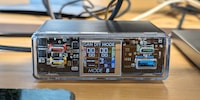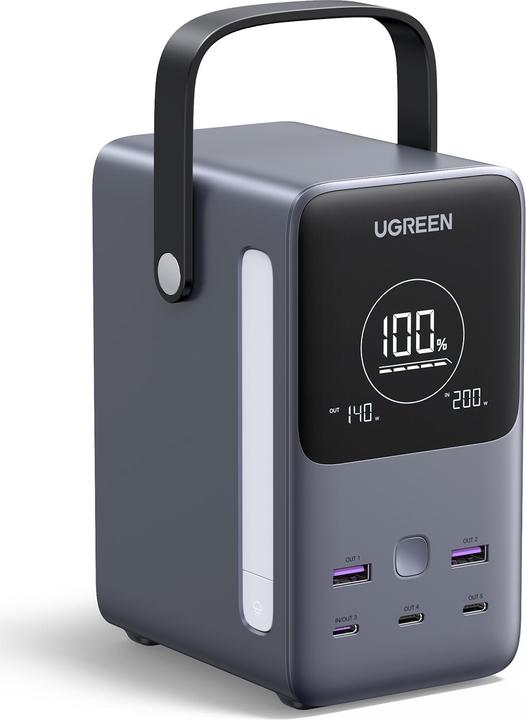
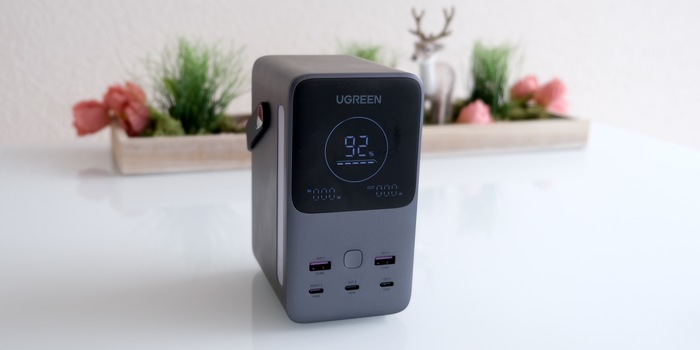
Heavy, but seriously fast: UGreen Nexode power bank review
The Nexode power bank from UGreen offers 48,000 mAh of charging – more than your usual portable models. It’s pretty hefty as a result, but offers more advantages in return.
I’ll start with the positives. After all, that’s how I lured you into reading this article. The disadvantages of this portable power bank will follow further down.
First of all, the UGreen device offers greater output than most power banks, namely up to 300 watts. This doesn’t mean, for example, that your laptop will charge at 300 watts. No, a maximum of 140 watts can be drawn from one of the three USB-C ports. This is still far more than almost all current notebooks require, mind you. They typically draw far under 100 watts. There are exceptions, such as the new MacBook Pro, which can take up to 140 watts when fast charging (linked page in German).
Incidentally, you can reach those fabled 300 Nexode watts if you connect three devices via USB-C cables. This way, 100 watts are provided per port.
The Nexode proves to be a real powerhouse when you want to recharge it at a power socket. The supplied USB-C cable with Power Delivery 3.1, in combination with a 140-watt power supply unit, ensures a charge from 0 to 100 per cent in less than 90 minutes. With weaker power supply units, which I’ve also tested, you’ll need considerably more patience. Charging with an 87-watt power supply unit will take around two hours, while using a 30-watt unit needs almost six.
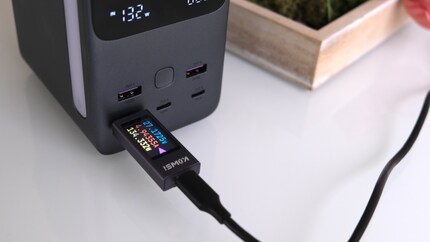
Second benefit: the UGreen Nexode is very durable, mainly because its power is stored in lithium iron phosphate batteries, LiFePO4 for short. With these, the Nexode manages significantly more charging cycles than lithium-ion batteries. The so-called cycle life of LiFePO4 is between 2,000 and 3,000 without any significant loss of capacity. By comparison, lithium-ion batteries have a service life of 500 to 1,000 cycles before their capacity noticeably diminishes.
Trickle charging for an even longer service life
UGreen has also given the Nexode a trickle charge function. You can activate it by pressing the start button three times. The display then switches to a somewhat strange mode: the figure on the right partially vanishes and reappears. I first had to read up what this means since I initially suspected an error. But be that as it may, it’s intentional.
What happens in the power bank is more important. When trickle charging is active, a connected device charges at a very low voltage. UGreen calls it a «slow and steady current flow». This way the power bank doesn’t lose its charge as quickly and the battery life is increased since excessive stress due to fast charging is avoided. You can gently charge both the connected devices and the Nexode itself in this way.
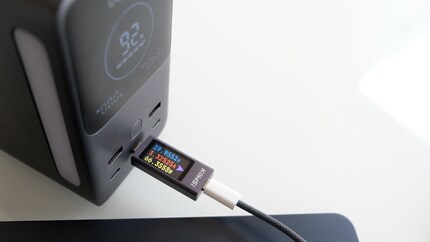
A camping companion
But who is UGreen’s Nexode made for? Certainly not for your suitcase on a flight. With its 48,000 mAh (equivalent to 153.6 Wh), it has to remain on the ground in accordance with airline safety regulations. It might feel more at home in a camper van. Or on a long train journey in carriages without sockets. You can easily recharge a MacBook Air once or an iPhone ten times with a full Nexode. With its endurance, the power bank could also serve as a charging station in your home if there’s no power socket nearby.
Potential buyers might also be found in areas where a hurricane could paralyse the power supply. A solid power bank makes perfect sense here as part of an emergency supply. Especially as the UGreen Nexode also has an LED strip in its housing and can light up for 150 hours on the lowest setting. At higher levels, it still lasts well over 100 hours.
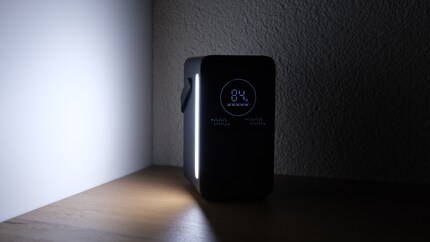
Charging from five ports
Whether it’s in real emergency situations after a natural disaster or simply for convenience – with five charging ports on the front, the Nexode offers a very decent range of features. As a digital explorer, you can charge several gadgets important to you at the same time via three USB-C and two USB-A ports. The two USB-A ports offer 22.5 watts. The three USB-C ports each carry at least 100 watts, while the bottom left port has 140.
But not always; it depends on which combination you use for the slots. For example, if you’ve plugged in two USB-A cables at the top, the lower USB-C ports are down regulated by the charging management. Learning the scheme feels like an overly ambitious undertaking to me. Personally, I’d only charge via USB-C whenever possible. UGreen deserves praise since all five ports are clearly labelled and give you an indication of what the maximum output is.
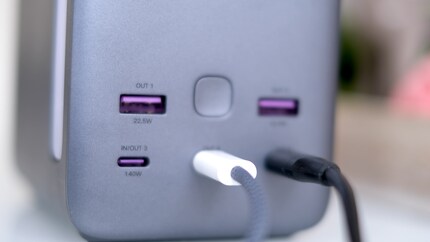
A wasted opportunity
The display of the power bank is located above the connections. It isn’t particularly bright. On the one hand, the display is a little dull. On the other, the amount of information is quite meagre as well. Across six by five centimetres, I get a ring displaying the charge level of the Nexode as a percentage. Below this, there’s another bar with five lines, providing the same information in a different form and less granular.
At the bottom left, I can see the power consumption while charging the power bank itself. The bottom right shows how many watts the Nexode is currently emitting. This combines all connected devices, so I can’t distinguish each individual port.
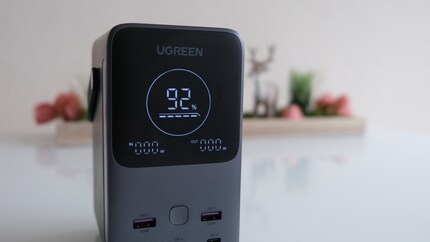
Incidentally, the display always lights up when the Nexode is in operation, whether it’s charging at the socket or supplying power to devices. After three minutes, the display dims slightly. It can’t be switched off completely.
Heavy and well built
The Nexode weighs an impressive 1,640 grammes. During my test, I’m grateful that UGreen screwed on a solid carrying handle. Like everything else on the appliance, it’s made of plastic. Still, it feels pleasant. I didn’t notice any defects in the manufacturing during my test either. Everything is glued cleanly and flush, leaving a durable impression.
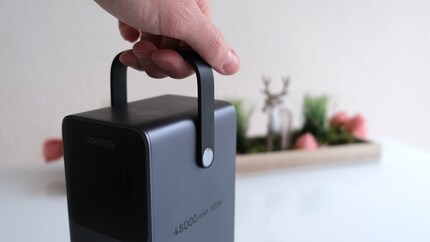
In particular, I like that the Nexode can both stand upright as well as lay on its side. There are two rubberised feet on each side at the bottom to prevent the heavy thing from accidentally slipping off your table.
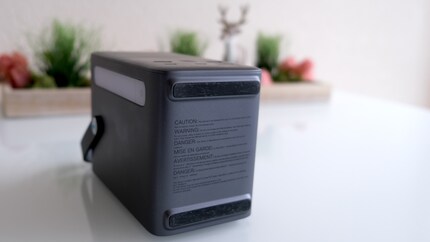
I was pleasantly surprised by the low heat development. Despite its high performance, the Nexode doesn’t get hot. When charging at maximum power, I measure no more than 40 degrees Celsius on the housing with my infrared sensor. Only behind the display does the temperature rise to almost 50 degrees Celsius. All values that won’t burn your fingers.
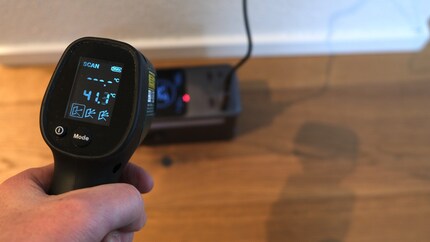
I noticed one material defect on my test device. A kind of spot can be seen on the display under a certain angle of light. This is primarily an optical problem, and doesn’t impair the function in the slightest. Maybe I was just unlucky here. If I’d bought the Nexode, I’d probably still complain about it and demand a replacement device. After all, the power bank is no bargain and should accompany me around the house and on the road for a long time.
In a nutshell
Lots of power wherever you need it
Pro
- Sophisticated details such as a carrying handle and double rubber feet
- Solid manufacturing
- Long-life LiFePO4 batteries
- Very fast charging (with the right power supply unit)
- High output for power-hungry devices
- 240-watt cable included with the device
Contra
- Rudimentary display
- Power supply unit not included

Journalist since 1997. Stopovers in Franconia (or the Franken region), Lake Constance, Obwalden, Nidwalden and Zurich. Father since 2014. Expert in editorial organisation and motivation. Focus on sustainability, home office tools, beautiful things for the home, creative toys and sports equipment.


